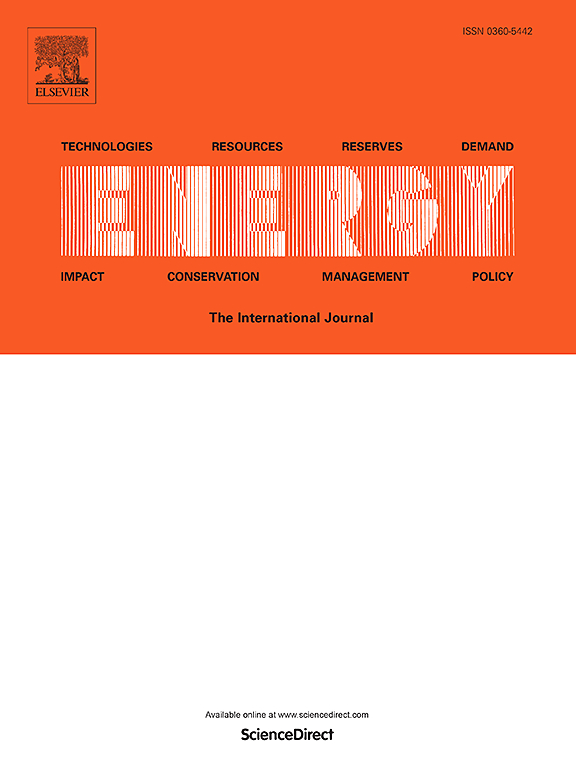Experimental study on CO2 flooding in tight sandy conglomerate cores: Oil displacement and CO2 storage
IF 9
1区 工程技术
Q1 ENERGY & FUELS
引用次数: 0
Abstract
The unique lithology of tight sandy conglomerate leads to severe microscopic heterogeneity, which significantly affects CO2 flooding. In this paper, four lithologies were classified according to gravel size and content, then CO2 flooding experiments were conducted to analyze the impacts of CO2 injection rate, miscible degree, reservoir temperature, and rock lithology. The results show that during initial stage, dissolved gas flooding governs efficient oil production, CO2 storage is mainly free storage in pores and dissolved storage in oil. Following breakthrough, CO2 sweep expands significantly, leading to sustained oil production. Concurrently, dissolved storage decreases while free storage increases. After channeling, oil production rate and storage efficiency decays rapidly. Besides, increasing CO2 injection rate enhances displacement effect, with the highest oil recovery and CO2 storage factor of 37.96 % and 10.7 % at 0.1 mL min−1. However, excessive injection rate induces premature breakthrough and exacerbates channeling, diminishing displacement efficiency. Under miscible condition, extraction of light hydrocarbons by CO2 enhances, increasing oil recovery and CO2 storage factor by 17.7 % and 3.28 %. Increasing reservoir temperature enhances oil fluidity, improving oil recovery factor by 10.93 %, but CO2 storage diminishes. The lithology difference of tight sandy conglomerate induces severe microscopic heterogeneity, diminishing displacement efficiency. As gravel size and content increase, core's permeability increases but porosity decreases, leading to limited oil supply. And compounded by dual tortuosity in such cores, fluid migration pathways become increasingly tortuous, further exacerbating channeling. Therefore, compared with gravel-bearing coarse sandstone, oil recovery and CO2 storage factor in sandy coarse conglomerate decrease by 7.41 % and 4.49 %.

致密砂砾岩岩心CO2驱油实验研究:驱油与CO2封存
致密砂砾岩独特的岩性特征导致其微观非均质性严重,对CO2驱油有重要影响。根据砾石粒度和含量对4种岩性进行了分类,并进行了CO2驱油实验,分析了CO2注入速率、混相度、储层温度、岩性等因素对储层的影响。结果表明:在初始阶段,溶气驱控制着高效采油,CO2的储存主要是孔隙中的游离储存和油中的溶解储存;突破后,二氧化碳波及范围显著扩大,从而实现持续的石油生产。同时,溶解储存量减少,自由储存量增加。窜油后,原油产量和储油效率迅速下降。此外,增加CO2注入量可以增强驱替效果,在0.1 mL min - 1条件下,采收率和CO2储存系数最高,分别为37.96%和10.7%。然而,过高的注入速度会导致过早突破,加剧窜流,降低驱替效率。在混相条件下,CO2对轻烃的萃取作用增强,原油采收率和CO2储存系数分别提高17.7%和3.28%。提高储层温度可提高油的流动性,使采收率提高10.93%,但CO2储量降低。致密砂砾岩的岩性差异造成了严重的微观非均质性,降低了驱替效率。随着砾石粒度和含量的增加,岩心渗透率增加,孔隙度降低,导致供油受限。再加上这些岩芯的双重弯曲,流体运移路径变得越来越曲折,进一步加剧了通道。与含砾粗砂岩相比,砂质粗砾岩的原油采收率和CO2储存系数分别降低了7.41%和4.49%。
本文章由计算机程序翻译,如有差异,请以英文原文为准。
求助全文
约1分钟内获得全文
求助全文
来源期刊

Energy
工程技术-能源与燃料
CiteScore
15.30
自引率
14.40%
发文量
0
审稿时长
14.2 weeks
期刊介绍:
Energy is a multidisciplinary, international journal that publishes research and analysis in the field of energy engineering. Our aim is to become a leading peer-reviewed platform and a trusted source of information for energy-related topics.
The journal covers a range of areas including mechanical engineering, thermal sciences, and energy analysis. We are particularly interested in research on energy modelling, prediction, integrated energy systems, planning, and management.
Additionally, we welcome papers on energy conservation, efficiency, biomass and bioenergy, renewable energy, electricity supply and demand, energy storage, buildings, and economic and policy issues. These topics should align with our broader multidisciplinary focus.
 求助内容:
求助内容: 应助结果提醒方式:
应助结果提醒方式:


